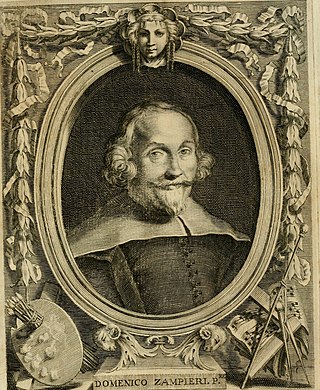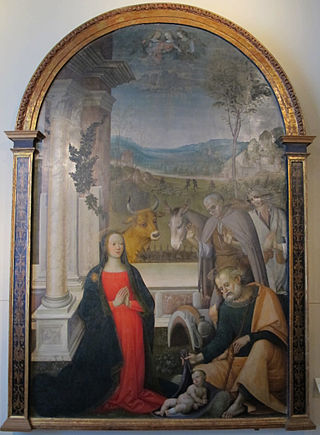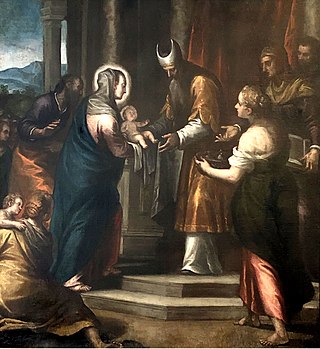
Giovanni Angelo d'Antonio (15th century) was an Italian Renaissance painter belonging to the Camerino school that also included Giovanni Boccati and Girolamo di Giovanni.

Giovanni Angelo d'Antonio (15th century) was an Italian Renaissance painter belonging to the Camerino school that also included Giovanni Boccati and Girolamo di Giovanni.
D'Antonio was born in a peasant community in the mountain village of Bolognola between 1415 and 1420. [1] His father was known as Antonio di Domenico "the madman". [1] The first records of Giovanni Angelo d'Antonio date from 1443, after he had just made a trip to Florence that included a meeting with Giovanni di Cosimo de' Medici. [1] After a second visit in 1444, he returned to Camerino to produce his first notable work, Madonna e santi [2] (1445), now at Palazzo di Venezia in Rome. [1] The picture, painted for the church of San Michele Arcangelo di Bolognola at which his brother, don Pietro, was the priest from 1441, shows the influence of the Florentine School and of Filippo Lippi in particular. [1]
In 1449 he was commissioned to work on a fresco for a chapel in Sant'Agostino in Camerino. [1]
It is hypothesised that he may have made a visit to Padua with his friend and fellow Camerino school painter Giovanni Boccati, which would explain the change in his style in the 1450s. [1]
His most significant work is considered to be the Annunciazione [3] from the convent at Spermento, most likely commissioned by Elisabetta Malatesta da Varano, and painted between 1455 and 1456. [1]
His most successful period followed, lasting into the 1460s, during which his work reveals an understanding of the way in which Piero della Francesca was using light. Works from this period include the Crocifissione e santi at Castello di Fiordimonte (1456), the Madonna e santi from the church of San Francesco (1462), and the Madonna della Misericordia at Villa di Montalto (1468). [1]
His final major piece was undertaken in his seventies. He returned to work in his small home town to fresco a Madonna and child with various saints in a roadside shrine near Bolognola. The shrine frescoes have now been removed to the Pinacoteca Civica in Camerino and restored. [1] [4]
Giovanni Angelo d'Antonio made his last Will and testament in 1478 and was dead by 1481. [1]
Until a radical reassessment in 2001 much of his work had been attributed to Girolamo di Giovanni (who is thought to be Giovanni Boccati's son). The contribution made by Giovanni Angelo d'Antonio to the reputation of the Camerino school of the 15th century is now considered at least as significant as that made by Giovanni Boccati and Girolamo di Giovanni. [1]

Lorenzo Lotto was an Italian Renaissance painter, draughtsman, and illustrator, traditionally placed in the Venetian school, though much of his career was spent in other north Italian cities. He painted mainly altarpieces, religious subjects and portraits. He was active during the High Renaissance and the first half of the Mannerist period, but his work maintained a generally similar High Renaissance style throughout his career, although his nervous and eccentric posings and distortions represented a transitional stage to the Florentine and Roman Mannerists.

Fabriano is a town and comune of Ancona province in the Italian region of the Marche, at 325 metres (1,066 ft) above sea level. It lies in the Esino valley 44 kilometres (27 mi) upstream and southwest of Jesi; and 15 kilometres (9 mi) east-northeast of Fossato di Vico and 36 kilometres (22 mi) east of Gubbio. Its location on the main highway and rail line from Umbria to the Adriatic make it a mid-sized regional center in the Apennines. Fabriano is the headquarters of the giant appliance maker Indesit.

Domenico Zampieri, known by the diminutive Domenichino after his shortness, was an Italian Baroque painter of the Bolognese School of painters.

Alessandro Bonvicino, more commonly known as Moretto, or in Italian Il Moretto da Brescia, was an Italian Renaissance painter from Brescia, where he also mostly worked. His dated works span the period from 1524 to 1554, but he was already described as a master in 1516. He was mainly a painter of altarpieces that tend towards sedateness, mostly for churches in and around Brescia, but also in Bergamo, Milan, Verona, and Asola; many remain in the churches they were painted for. The majority of these are on canvas, but a considerable number, including some large pieces, are created on wood panels. There are only a few surviving drawings from the artist.

Giacomo Pacchiarotti or Jacopo Pacchiarotto was an Italian painter.

Carlo Cignani was an Italian painter. His innovative style referred to as his 'new manner' introduced a reflective, intimate mood of painting and presaged the later pictures of Guido Reni and Guercino, as well as those of Simone Cantarini. This gentle manner marked a break with the more energetic style of earlier Bolognese classicism of the Bolognese School of painting.

Vincenzo Foppa was an Italian painter from the Renaissance period. While few of his works survive, he was an esteemed and influential painter during his time and is considered the preeminent leader of the Early Lombard School. He spent his career working for the Sforza family, Dukes of Milan, in Pavia, as well as various other patrons throughout Lombardy and Liguria. He lived and worked in his native Brescia during his later years.

Antonio Balestra was an Italian painter of the Rococo period.

Alessandro Maganza (1556–1630) was an Italian painter of the Mannerist style, born and active in Vicenza, as well as in Venice.

Antonio d'Enrico, called Tanzio da Varallo, or simply il Tanzio was an Italian painter of the late-Mannerist or early Baroque period.
The decade of the 1460s in art involved some significant events.

Biagio d’Antonio Tucci was an Italian Renaissance painter active in Florence, Faenza and Rome.

Giovanni Boccati or Giovanni di Pier Matteo Boccati was an Italian painter.

Antonio del Massaro da Viterbo, or Antonio da Viterbo, nicknamed il Pastura was an Italian painter.

Dono Doni, also known as Adone Doni or Dono dei Doni (1505-1575) was an Italian painter of the Renaissance period active mainly in Umbria.

Ottaviano Nelli (1375–1444?) was an Italian painter of the early Quattrocento. Nelli primarily painted frescoes, but also panel paintings. He had several pupils and two painters were influenced by him.

Camerino Cathedral is a Neoclassical Roman Catholic cathedral and minor basilica, dedicated to the Annunciation, in Camerino, Region of Marche, Italy. Since 1987 it has been the seat of the Archbishop of Camerino-San Severino Marche, having been the seat of the Archbishops of Camerino from 1787 and previously that of the Bishops of Camerino.
Paolo Bontulli was an Italian painter, mainly of sacred subjects.
The Master of Staffolo was an anonymous late-Gothic style painter active in the region of Marche and Umbria.

Giovanni Battista Ramenghi was an Italian painter. He is sometimes known as Bagnacavallo junior or Bagnacavallo the Younger to distinguish him from his father Bartolomeo Ramenghi.